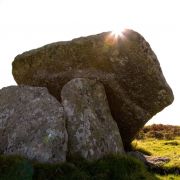Neolithic dolmen
The Neolithic Mulfra Quoit sits high on the West Cornwall moors with wide reaching views over the landscape and sea. It is similar in structure to nearby Chûn Quoit but less well preserved.
The quoit is a typical Cornish dolmen which would have originally formed an inner stone burial chamber under a mound of earth. Early descriptions mention a low stone embankment that surrounded the quoit along with around 30cm (1ft) of soil which probably formed part of the mound. All sign of these has now gone.
The five ton, 3 metre (10ft) wide capstone now lies at an angle of 45 degrees after it was reputedly dislodged during a mighty thunderstorm in 1752. Coincidentally this is the same fate that befell Lanyon Quoit although was rebuilt in the 19th century. Doubt has been cast on this version of events by the Victorian antiquarian William Copeland Borlase who stated that his great-great-grandfather had recorded the site in the same state as far back as 1749.
A more likely explanation is that the capstone slipped after one of the supporting stones was removed. Today there are three supporting stones set at right-angles forming a U shape. It is likely there would have been a fourth to complete the chamber as at Chûn Quoit.
Excavations of Mulfra Quoit by W.C. Borlase revealed only charred wood apparently sealed over by clay which sat within the chamber of the quoit.
There are several Bronze Age barrows in the vicintiy of the quoit. These are located along the ridge to the north.







